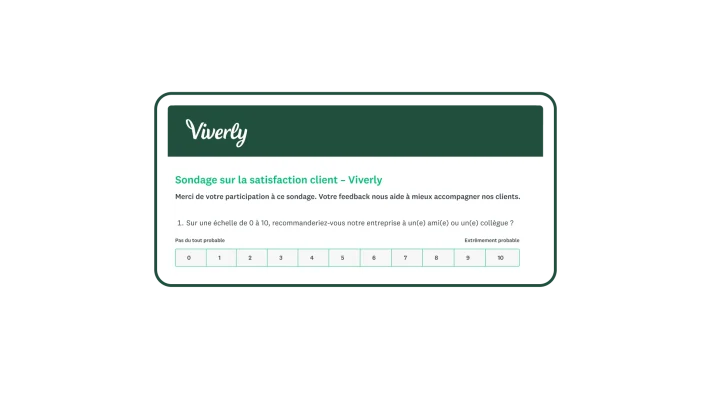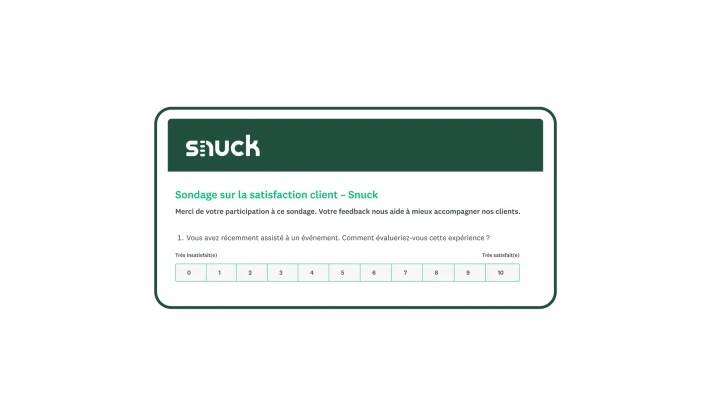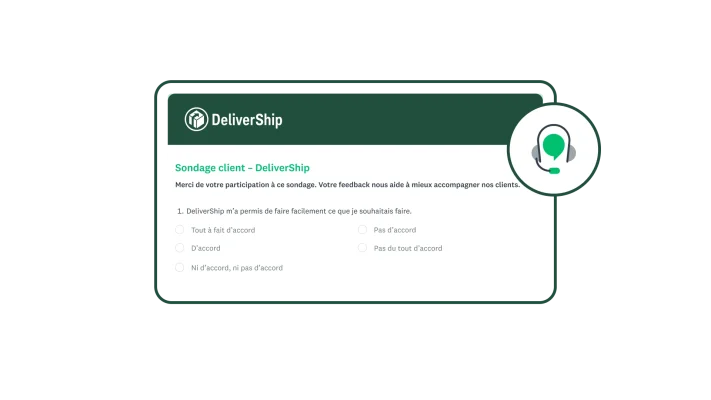Les clés d'un programme Voix du client (VoC) performant

Avez-vous déjà évité une marque à cause de commentaires négatifs que vous aviez entendus ? Ou renoncé à un achat parce que l'entreprise vous a déçu ?
Auquel cas, avez-vous contacté ces entreprises pour leur dire que vous n’achèteriez plus leurs produits ? Probablement pas.
De toute manière, si vous êtes en charge de l’expérience client (CX), vous ne pouvez pas attendre que les clients vous contactent. Au contraire, c’est vous qui devez entamer la conversation via le programme de Voix du client (VoC, Voice of the Customer) de votre entreprise.
Qu’est-ce qu’un programme de Voix du client ?
Définition de la Voix du client : un programme de Voix du client regroupe la collecte, l’analyse et la surveillance systématiques des interactions des clients avec vos différents produits, services ou marques.
Un programme VoC est important pour l’expérience client globale. Il représente votre engagement à prendre des mesures en réponse aux feedbacks des clients. Son objectif principal doit être de faire correspondre les performances de votre entreprise aux attentes des clients. Si vous appliquez un programme de Voix du client efficace, vous donnez même à vos employés les moyens de dépasser ces attentes.
Allez plus loin que la collecte du feedback, avec un programme de Voix du client
De nombreuses entreprises demandent l’avis de leurs clients via des sondages, des formulaires et des groupes de discussion. Mais un programme de Voix du client va plus loin. Lorsque vous créez un programme VoC pour votre entreprise, vous faites de l’engagement, de la fidélité et de la satisfaction des clients des aspects essentiels de votre stratégie d’entreprise. Un programme VoC efficace inclut :
- Des objectifs commerciaux concrets
- Le soutien de l’équipe de direction
- La participation et la collaboration des employés
- Une compréhension approfondie du parcours client
- Une écoute proactive des clients sur tous les canaux et les points de contact
- Des études de marché et des sondages réguliers auprès des clients
- Des analyses de données et des rapports détaillés
- Une bonne communication interne
Plus important encore, un bon programme de Voix du client suggère des actions concrètes à mettre en œuvre. Boucler la boucle du feedback doit être une priorité. Cela implique d’identifier des axes d’amélioration, de résoudre des problèmes et d’informer les employés et les clients des changements effectués.
Dans cet article, vous apprendrez à créer votre propre programme de Voix du client, de la planification jusqu’à la mise en œuvre. Vous découvrirez des astuces, des indicateurs clés et des ressources telles que ces modèles de sondages sur la Voix du client.
Créez votre programme Voix du client
1. Obtenez le soutien de votre équipe de direction
Créer un programme VoC, ou simplement mettre à jour un programme existant, demande du temps et des ressources. Avant de vous lancer, rassemblez les informations nécessaires et prévoyez une réunion avec vos responsables pour vous assurer d’un consensus sur les points suivants :
- Les principaux problèmes des clients, ou les indicateurs inquiétants (par exemple, une augmentation annuelle du taux d’attrition de 5 %).
- Ce qu’est un programme VoC, ou comment votre programme VoC existant pourrait être amélioré.
- L’importance de prioriser l’écoute des clients et d’agir en conséquence, avec quelques exemples que vous pouvez prendre dans d’autres entreprises. Par exemple, l’entreprise de bus Greyhound a augmenté de 15 points une mesure importante de la fidélité client, avant de modifier en profondeur son expérience client. Résultat : sa rentabilité a augmenté.
2. Définissez vos objectifs en consultant les personnes concernées
Une fois que vous avez le soutien de la direction, identifiez les différentes équipes avec lesquelles vous devez travailler. Chaque équipe aura un point de vue unique sur l’expérience client et les différentes manières de l’améliorer.
- Le service client travaille en contact direct avec vos utilisateurs. vos équipes ont donc une bonne compréhension des points faibles et des problèmes éventuels liés à votre produit ou service.
- Le marketing et la communication ont des informations importantes concernant les concurrents et le marché. Ces équipes peuvent également communiquer directement avec les consommateurs via les réseaux sociaux.
- L’équipe des ventes a une bonne idée de la sensibilité aux prix, des produits et solutions proposés par la concurrence, et des messages qui fonctionnent (ou pas) auprès des prospects.
- Les équipes produit peuvent vous aider à comprendre comment les utilisateurs interagissent avec vos produits et services, notamment grâce à des données telles que les taux d’attrition, d’erreur ou d’abandon. Elles peuvent également vous aider à mieux comprendre le fonctionnement de vos produits, ainsi que les problèmes ou les bugs susceptibles de nuire à la satisfaction client.
- Les ressources humaines ont des insights précieux sur l’expérience de vos équipes internes. L’engagement des employés est-il suffisant ? Les employés ont-ils l’impression de pouvoir influencer positivement l’expérience client ?
Chacune de ces équipes peut avoir des objectifs légèrement différents. Pour commencer, vous pouvez choisir un objectif commun à toute l’entreprise (par exemple, « améliorer de 10 % le taux de satisfaction client ») et encourager chacune de vos équipes à définir son propre objectif.
Gardez à l’esprit que les efforts doivent être centrés sur le client. Une équipe produit pourrait souhaiter améliorer l’expérience d’intégration des nouveaux clients, pour augmenter le nombre d’inscriptions. Mais dans le cadre d’un programme de Voix du client, il serait préférable que vos équipes produits et service client collaborent pour définir les objectifs. Le service client pourrait identifier les points faibles de l’expérience d’intégration, et l’équipe produit pourrait les résoudre afin de réduire le nombre de demandes d’assistance.
3. Créez une carte de votre parcours client
Rassemblez les équipes concernées et discutez de la manière dont les clients ou prospects interagissent avec votre marque avant, pendant et après l’achat. C’est ce que l’on appelle la cartographie du parcours client. Cela vous permettra de mettre en évidence les meilleurs moments où collecter du feedback, d’en savoir plus sur un point de contact particulier, ou encore de combler une éventuelle lacune dans l’expérience client. Les points de contact client se retrouvent avant, pendant et après l’achat. Quelques exemples :
- Avant l’achat : publicité, bouche-à-oreille, réseaux sociaux
- Pendant l’achat : site Web, boutique, point de vente
- Après l’achat : facturation, emails de transactions, centre d’aide en ligne
Lorsque vous créez votre carte du parcours du client, vous devez également noter quand, où et à quelle fréquence vous recueillez du feedback. Vous pourrez ainsi affiner vos sondages, et en améliorer à la fois la planification et le suivi.
Apprenez à cartographier votre parcours client
Suivez nos conseils détaillés pour créer une carte du parcours client : répondez aux attentes de vos parties prenantes et atteignez vos objectifs commerciaux.
4. Donnez la parole à vos clients
Un programme de Voix du client vous permet de recueillir des commentaires structurés et non structurés (quantitatifs et qualitatifs).
Les données structurées sont des données quantifiables ou mesurables. Par exemple : vous demandez à vos clients d’évaluer la probabilité qu’ils achètent à nouveau l’un de vos produits. Puisque vous leur demandez de choisir parmi des options prédéfinies, les résultats ont une valeur numérique. Disons que 76 % des clients déclarent qu’ils achèteraient de nouveau votre produit.
À l’inverse, les données non structurées sont qualitatives, mais non mesurables. Par exemple, dans un sondage sur l’expérience d’achat, vous demandez à une personne de vous expliquer pourquoi il est « Très probable » qu’elle achète de nouveau vos produits et services. Proposez-lui de rédiger une réponse dans un champ de texte pour vous en dire davantage. Les réponses que vous obtiendrez vous aideront à comprendre vos résultats chiffrés.
Pour obtenir une vision globale de l’expérience client, vous avez tout intérêt à collecter les deux types de données. Voici différentes manières de demander régulièrement les avis de vos clients dans le cadre d’un programme de Voix du client efficace :
- Assurez-vous de recueillir des commentaires via des sondages de satisfaction client à des moments clés, par exemple après un achat ou une interaction avec le service client.
- Encouragez toutes vos équipes à discuter avec vos équipes commerciales et votre service client une fois par trimestre.
- Effectuez régulièrement des recherches en expérience client ou utilisateur pour obtenir des informations sur la concurrence, et voir dans quelle mesure vous pouvez améliorer votre produit ou service.
- Organisez des groupes de discussion et des entretiens avec vos clients pour obtenir des informations approfondies.
- Utilisez l’écoute des réseaux sociaux pour comprendre comment votre marque est perçue.
5. Mesurez les indicateurs clés pour la Voix du client
Généralement, les entreprises utilisent certains indicateurs de Voix du client standards pour comprendre l’expérience client. Voici trois des indicateurs VoC les plus populaires.
Net Promoter Score (NPS)

Quelle est la probabilité qu’une personne recommande votre entreprise à des amis ou collègues ? Le sondage Net Promoter® Score (NPS) vous offre une réponse quantifiable et facilement traçable à cette question. Découvrez les avantages d’un sondage NPS.
- Calcul NPS simple : les participants donnent une évaluation comprise entre 0 et 10, et le score obtenu est un nombre compris entre -100 et +100.
- Traçable et pratique : la question Net Promoter Score est simple et adaptable selon vos besoins. Vous pouvez demander si une personne recommanderait votre marque, votre application ou votre logiciel. La question NPS n’est pas liée à un événement spécifique. C’est donc un bon indicateur des performances de votre entreprise à tout moment.
- Benchmarks du secteur utiles : puisque de nombreuses entreprises utilisent le NPS, vous pouvez comparer vos actions à celles d’autres entreprises de votre secteur d’activité. Par exemple, notre analyse de centaines de sondages NPS indique que le score moyen du secteur de la santé est de 38.
Score de satisfaction client (CSAT)

Alors que le NPS est un indicateur de la fidélité des clients dans le temps, le Score de satisfaction client (ou CSAT, Customer Satisfaction Score) vous permet de comprendre le ressenti de vos clients après une interaction spécifique avec votre marque. Voici quelques informations à connaître sur le sondage CSAT.
- Un excellent complément au NPS : le CSAT et le NPS sont tous les deux des indicateurs VoC importants, qui vous donnent des informations complémentaires sur l’expérience client.
- Spécifique et exploitable : utilisez les données de votre sondage CSAT pour apporter des améliorations ciblées à l’expérience client. Vous pouvez obtenir des commentaires sur le service client ou mesurer la satisfaction des participants en recueillant leur feedback sur un événement.
- Facile à calculer et à analyser : les options de réponse d’un sondage CSAT sont basées sur une échelle numérique, comme 1-5. Vous pouvez voir les données brutes (par exemple, 478 clients se déclarent « Très satisfaits » de leur dernière interaction avec votre service client) ou afficher les résultats sous forme de pourcentage.
Customer Effort Score (CES)

Les clients parviennent-ils facilement à obtenir ce qu’ils souhaitaient lorsqu’ils interagissent avec votre entreprise ? Le Customer Effort Score (CES) mesure les efforts que doivent fournir vos clients pour accomplir une tâche. Il vous aide à identifier les principaux points problématiques du parcours client, lorsque vos clients utilisent votre logiciel ou lorsqu’ils essaient de résoudre un problème spécifique, par exemple. Découvrez les principaux avantages des sondages CES dans un programme de Voix du client.
- Améliorer la fidélité des clients : selon notre étude, 91 % des personnes interrogées sont susceptibles de recommander une entreprise après une expérience positive qui a nécessité peu d’efforts.
- Trouver des pistes d’amélioration rapides : un simple message peu clair peut dissuader un client d’effectuer un achat. Et si modifier quelques mots dans le processus de paiement suffisait à améliorer vos résultats ?
- Créer de meilleurs programmes de formation : utilisez les sondages CES pour comprendre les points faibles de votre service client, par exemple une durée de résolution trop longue. Lorsque vous savez ce qui gêne vos clients, vous pouvez adapter la formation de votre service client, et dans ce cas précis, résoudre plus rapidement les problèmes.
6. Analysez les résultats
Une fois que vous avez commencé à collecter le feedback client sur tous les points de contact, examinez chaque ensemble de données et comparez les résultats.
- Demandez aux différentes équipes de partager les connaissances acquises à partir d’études de marché et de sondages clients, que ce soit sur les réseaux sociaux ou d’une autre manière. Centralisez ces informations dans un seul endroit, comme un wiki ou site Web interne.
- Certaines données, comme le Net Promoter Score, sont facilement compréhensibles. Mais si vos sondages incluent des questions ouvertes, il est conseillé d’utiliser un outil d’analyse de texte pour découvrir les tendances cachées.
- Vous devrez peut-être recouper les données de vos sondages avec des outils d’analyse avancés tels que des filtres personnalisés, qui peuvent vous fournir des insights clients plus précis.
7. Passez à l’action, suivez le programme et recommencez
Une fois que vous avez défini votre stratégie d’écoute des clients, vous devez traiter tous les problèmes urgents détectés, tels qu’un NPS en déclin ou un score de satisfaction client médiocre.
À long terme, pensez à créer un cadre pour maintenir un programme VoC solide pour votre entreprise. Voici quelques idées :
- Influencez les feuilles de route produit : demandez aux équipes produit de résoudre chaque trimestre un ou deux problèmes majeurs remontés par les clients.
- Améliorez la formation et les performances de votre service client. En fonction des problèmes identifiés, vos équipes peuvent donner la priorité à une meilleure intégration des employés, ou dispenser une formation sur l’empathie, par exemple. Rédigez des modèles de réponses aux questions les plus fréquemment posées par les clients, pour réduire le temps de réponse.
- Impliquez toute l’entreprise : deux fois par an, consacrez une à deux semaines à résoudre les problèmes des clients ou à répondre aux feedbacks essentiels.
- Placez vos clients au cœur de votre entreprise : invitez-les régulièrement à partager leur expérience avec vos équipes.
- Partagez les succès et les échecs : envoyez chaque mois à l’ensemble de l’entreprise un rapport mettant en évidence les feedbacks importants, les tendances et des témoignages de clients. Cela participera à motiver vos employés.
Les avantages d’un programme de Voix du client
Des clients satisfaits sont des clients fidèles, et généralement aussi des promoteurs. Mais un programme de Voix du client offre bien d’autres avantages, qui ne sont pas tous aussi évidents.
Améliorez l’engagement de vos employés
Lorsque vous créez un programme de Voix du client, vous donnez à votre personnel les moyens d’avoir un impact direct sur l’expérience client. Vous pouvez même encourager vos équipes à définir des objectifs centrés sur les clients, et récompenser leurs réussites.
Gagnez un avantage concurrentiel
La plupart des commentaires sont recueillis en réaction à un événement, ce qui signifie que vous ne pouvez comprendre le ressenti des clients qu’après leur interaction avec votre marque. Un programme VoC, lui, inclut également la collecte proactive de feedback. Groupes de discussion, entretiens avec les clients, écoute des réseaux sociaux, recherches sur les utilisateurs : autant de manières de solliciter du feedback afin de développer de nouveaux produits, de résoudre les problèmes des consommateurs, et plus encore.
Multipliez les témoignages clients et renforcez votre preuve sociale
Utilisez les commentaires élogieux de vos clients pour diffuser des témoignages puissants à propos de votre marque sur tous les canaux, des documents marketing jusqu’à votre site Web, en passant par les réseaux sociaux.
Relevez le défi et construisez un programme VoC solide
Difficulté n° 1 : les commentaires et les données clients sont cloisonnés
Études de marché, insights utilisateurs, commentaires du service client, interactions sur les réseaux sociaux, résultats de sondages : toutes ces données doivent être combinées pour fournir une vision globale de l’expérience client. Si les données sont cloisonnées, il est difficile de dégager des tendances et des améliorations possibles.
Chaque personne ou équipe doit être responsable de consigner ses conclusions et de les mettre à disposition de tous, dans un répertoire partagé. Vous pouvez simplifier la collecte et la gestion du feedback grâce aux intégrations de sondages pour Salesforce, HubSpot, MailChimp, Zendesk, Zoom et bien d’autres encore.
Difficulté n° 2 : les clients ne répondent pas aux sondages
Vous envoyez des sondages mais vous n’obtenez pas suffisamment de réponses pour obtenir des résultats statistiquement significatifs ? Vous pouvez, dans le cadre de votre programme de Voix du client, mener un audit des sondages : analysez chaque questionnaire en fonction d’une liste de vérification basée sur les bonnes pratiques en matière de sondage.
Vos clients risquent d’ignorer vos sondages s’ils sont trop longs ou pas assez clairs. Pour obtenir suffisamment de réponses, pensez aux modèles de sondages et aux questions de sondages de satisfaction client rédigés par des experts.
Et si vous ne comprenez toujours pas pourquoi les performances de vos sondages sont décevantes, suivez ces conseils pour améliorer les taux de réponse CSAT et ces bonnes pratiques pour les questions de sondages CSAT.
Difficulté n° 3 : certaines équipes sont réticentes
L’idée de satisfaire les clients ne suffit pas à motiver les équipes pour résoudre leurs problèmes ? Associez la satisfaction client aux revenus. Vous pouvez, par exemple, démontrer le retour sur investissement d’une amélioration de la satisfaction client en liant la valeur à vie d’un client fidèle au nombre de personnes déclarant qu’elles achèteraient à nouveau vos produits.
Appuyez vos demandes en partageant des études convaincantes avec les équipes réticentes. Notre étude indique notamment que 75 % des clients perdent confiance dans une entreprise après une mauvaise expérience avec un produit.
5 bonnes pratiques pour créer un programme de Voix du client
Concevez un programme VoC qui prend le pouls de vos clients en temps réel. Utilisez les bonnes pratiques suivantes pour engager le dialogue avec vos clients, rallier toutes les équipes de votre entreprise et créer un changement en profondeur.
- Faites attention aux données implicites. Les données implicites, telles que l’utilisation des applications ou le taux d’attrition, sont le pendant des commentaires explicites des clients. Si une personne vous dit qu’elle est satisfaite de votre application, mais qu’elle ne l’utilise plus, alors il est temps de lui poser d’autres questions.
- Avant de commencer votre analyse, nettoyez les données de votre sondage pour obtenir des résultats plus précis et mieux exploitables.
- En règle générale, plus vos employés sont heureux au travail, meilleure est l’expérience de vos clients. Travaillez avec les ressources humaines pour suivre l’engagement et la satisfaction de vos employés, avec un sondage eNPS par exemple. Vous pouvez même surveiller et suivre des indicateurs importants de l’engagement des employés, comme le NPS des employés, par rapport au NPS de votre clientèle.
- Analysez vos résultats en contexte. Bien sûr, vous suivez l’évolution de la satisfaction client au fil du temps. Mais vous devez aussi comparer vos résultats à ceux de la concurrence, pour savoir où vous vous situez dans votre secteur d’activité.
- Assurez-vous que votre programme Voix du client est à jour. Étudiez les principales tendances en matière d’expérience client, y compris la manière dont les professionnels CX utilisent l’IA et travaillent pour répondre aux attentes changeantes des consommateurs.
Commencez dès aujourd’hui à créer votre programme de Voix du client
Envoyez un sondage en quelques minutes grâce à l’un de ces modèles de sondages Voix du client rédigés par nos experts. Et si vous avez besoin d’une assistance un peu plus poussée, découvrez comment SurveyMonkey peut améliorer votre programme VoC.
Net Promoter, Net Promoter Score et NPS sont des marques commerciales de Satmetrix Systems, Inc., Bain & Company, Inc. et Fred Reichheld.
Autres ressources à votre disposition

Des solutions adaptées à votre rôle
Avec SurveyMonkey, maximisez l’impact de vos stratégies marketing, du développement de vos produits, de vos expériences client et plus encore.

Hornblower améliore son expérience client dans le monde entier
Hornblower collecte le feedback de ses clients, améliore leur expérience et optimise ses données NPS grâce à SurveyMonkey et ses fonctionnalités IA.

Satisfaction client : 8 stratégies pour l’améliorer
Découvrez ce qu’est la satisfaction client, comment l’évaluer et 8 stratégies qui aideront votre entreprise à réussir, dans ce guide complet.

Qu’est-ce qu’un bon score d’effort client ?
Apprenez à mesurer la satisfaction et l’expérience client à l’aide du Customer Effort Score (CES). Découvrez ce qu’est un bon score d’effort client.